#infrared space telescope
Explore tagged Tumblr posts
Text
new webb image(s) alert! 19 galaxies imaged in mid and near infrared light

i’m just blown away by the detail in these images- jwst never ceases to amaze me.
you can find the full resolution images of each of these galaxies in the official release here - i highly recommend looking through each of them, they’re STUNNING.
#aspaceinthecosmos#space#astronomy#outer space#just jupiter#astrophotography#galaxies#jwst#james webb space telescope#james webb#nasa#infrared astronomy
724 notes
·
View notes
Text

To celebrate the James Webb Space Telescope's second year of science, let’s look back at one of its first images, the Cartwheel Galaxy. This near- and mid-infrared image shows the areas where stars develop after a high-speed collision about 400 million years ago: https://bit.ly/3WfJYW2
#space#astronomy#stsci#science#nasa#universe#nasawebb#james webb space telescope#esa#galaxy#cartwheel#infrared#stars#pink
269 notes
·
View notes
Text
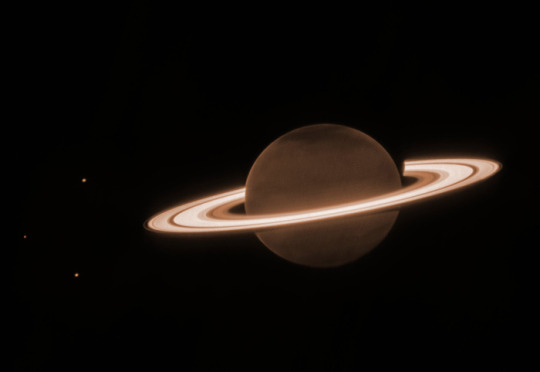
Saturn and its moons l Webb

#saturn#near infrared#solar system#webb#space#james webb telescope#astrophotography#astronomy#stars#night#galalxy#planets#sky
2K notes
·
View notes
Text
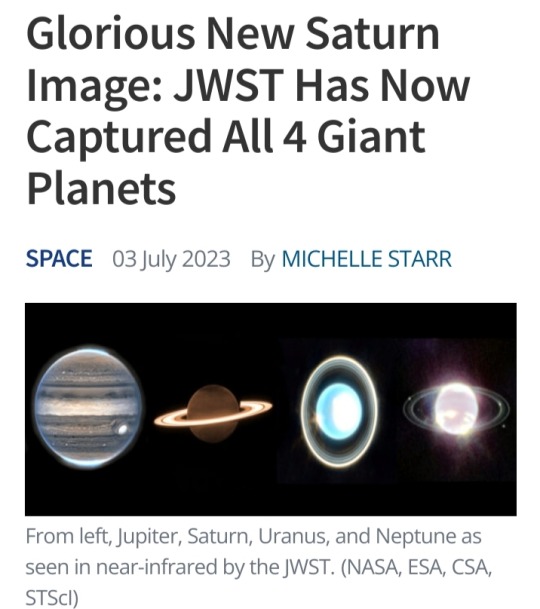
With the addition of Saturn, the James Webb Space Telescope has finally captured all four of our Solar System's giant worlds.
JWST's observations of the ringed planet, taken on 25 June 2023, have been cleaned up and processed, giving us a spectacular view of Saturn's glorious rings, shining golden in the darkness.
By contrast, the disk of Saturn is quite dark in the new image, lacking its characteristic bands of cloud, appearing a relatively featureless dim brown.
This is because of the wavelengths in which JWST sees the Universe – near- and mid-infrared.
These wavelengths of light are usually invisible to the naked human eye, but they can reveal a lot.
For example, thermal emission – associated with heat – is dominated by infrared wavelengths.
When you're trying to learn about what's going on inside a planet wrapped in thick, opaque clouds, studying its temperature is a valuable way to go about it.
Some elements and chemical processes emit infrared light, too. Seeing the planets of the Solar System in wavelengths outside the narrow range admitted by our vision can tell us a lot more about what they have going on.
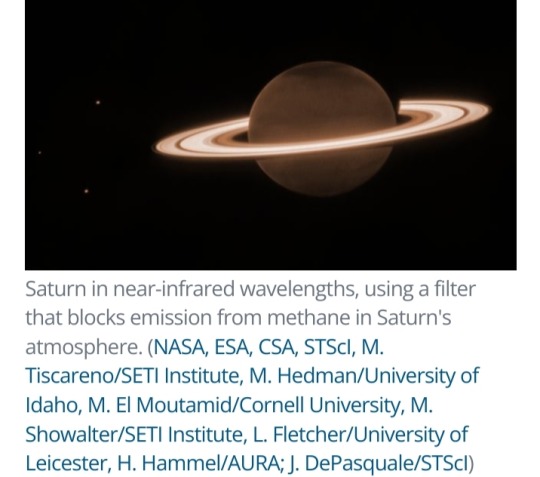
Saturn
As we saw last week, when we clapped eyes on the raw JWST Saturn images, the observations involved filters that dimmed the light of the planet, while allowing light from the rings and moons to shine brightly.
This is so a team led by planetary scientist Leigh Fletcher of the University of Leicester in the UK can study the rings and moons of Saturn in more detail.
They hope to identify new ring structures and, potentially, even new moons orbiting the gas giant.
The image above shows three of Saturn's moons, Dione, Enceladus and Tethys, to the left of the planet.
Although dim, the disk of the planet also reveals information about Saturn's seasonal changes.
The northern hemisphere is reaching the end of its 7-year summer, but the polar region is dark. An unknown aerosol process could be responsible.
Meanwhile, the atmosphere around the edges of the disk appears bright, which could be the result of methane fluorescence, or the glow of trihydrogen, or both. Further analysis could tell us which.
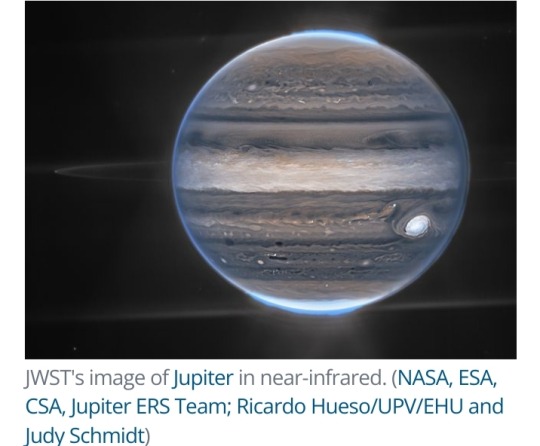
Jupiter
Jupiter was the first of the giant planets to get the JWST treatment, with images dropping in August of last year – and boy howdy were they stunning.
The spectacular detail seen in the planet's turbulent clouds and storms was perhaps not entirely surprising.
However, we also got treated to some rarely seen features: the permanent aurorae that shimmer at Jupiter's poles, invisible in optical wavelengths, and Jupiter's tenuous rings.
We also saw two of the planet's smaller, lesser-known moons, Amalthea and Adrastea, with fuzzy blobs of distant galaxies in the background.
"This one image sums up the science of our Jupiter system program, which studies the dynamics and chemistry of Jupiter itself, its rings, and its satellite system," said astronomer Thierry Fouchet of Paris Observatory in France, who co-led the observations.
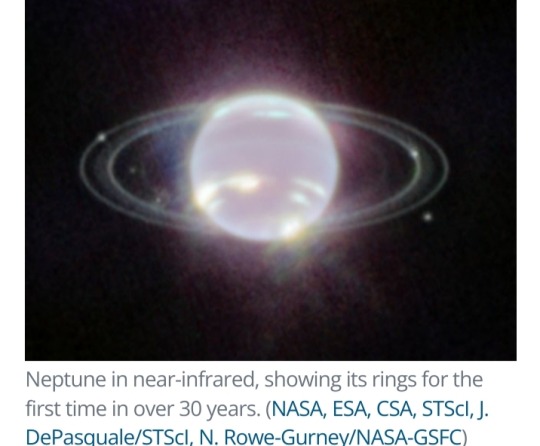
Neptune
Observations of Neptune arrived in the latter half of September 2022.
Because Neptune is so very far away, it tends to get a little neglected; you're probably used to seeing, if anything, the images taken by Voyager 2 when it flew past in 1989.
JWST's observations gave us, for the first time in more than 30 years, a new look at the ice giant's dainty rings – and the first ever in infrared.
It also revealed seven of Neptune's 14 known moons, and bright spots in its atmosphere.
Most of those are storm activity, but if you look closely, you'll see a bright band circling the planet's equator.
This had never been seen before and could be, scientists say, a signature of Neptune's global atmospheric circulation.
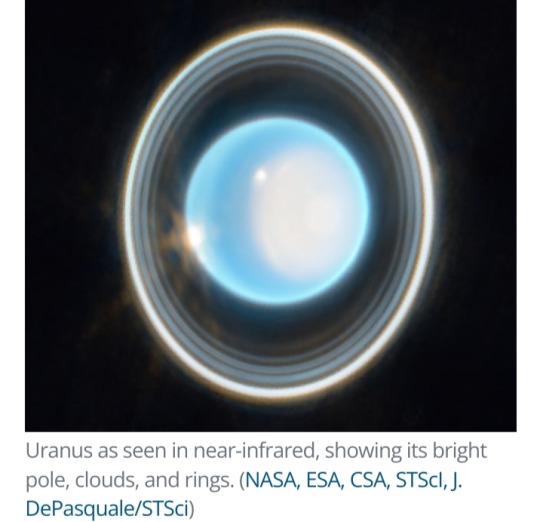
Uranus
Uranus is also pretty far away, but it's also a huge weirdo. Although very similar to Neptune, the two planets are slightly different hues, which is something of a mystery.
Uranus is also tipped sideways, which is challenging to explain too.
JWST's observations, released in April 2023, aren't solving these conundrums.
However, they have revealed 11 of the 13 structures of the incredible Uranian ring system and an unexplained atmospheric brightening over the planet's polar cap.
JWST has a lot to say about the early Universe; but it's opening up space science close to home, too.
As its first year of operations comes to an end, we can't help but speculate what new wonders will be to come in the years ahead.

Top: Jupiter - Neptune / Bottom: Uranus - Saturn
Credit: NASA
#James Webb Space Telescope#Solar System#Saturn#Jupiter#Uranus#Neptune#planets#space#universe#infrared wavelengths#wavelengths#JWST#Leigh Fletcher#planetary science#Thierry Fouchet#moons#Voyager 2#giant planets#astronomy
1K notes
·
View notes
Text

"This stunning new mosaic of images from the NASA/ESA/CSA James Webb Space Telescope showcases the nearby star-forming cluster, NGC 1333."
"These data constitute the first deep spectroscopic survey of the young cluster, and have identified brown dwarfs down to planetary masses using the observatory’s Near-Infrared Imager and Slitless Spectrograph (NIRISS). The first results from this survey have been accepted for publication in the Astronomical Journal."
source
#cosmos#universe#space#astronomy#esa#james webb space telescope#james webb telescope#stars#planets#nebula#technology#science#infrared#visible spectrum#color spectrum#spectrograph#spectroscope
60 notes
·
View notes
Text

SPACEMAS DAY 17 ✨🪐🌎☄️☀️🌕
The Ring Nebula (M57), is more complicated than it appears through a small telescope. The easily visible central ring is about one light-year across, but this remarkable exposure by the James Webb Space Telescope explores this popular nebula with an exposure in infrared light. Strings of gas, like eyelashes around a cosmic eye, become evident around the nebula in this digitally enhanced featured image in assigned colors. These long filaments may be caused by the shadowing of knots of dense gas in the ring from energetic light emitted within. The Ring Nebula is an elongated planetary nebula, a type of gas cloud created when a Sun-like star evolves to throw off its outer atmosphere to become a white dwarf star. The central oval in the Ring Nebula lies about 2,500 light-years away toward the musical constellation Lyra.
Image Credit & Copyright: NASA, ESA, CST, JWST
#astronomy#space#science#universe#nebula#ring nebula#spacemas#day 17#infrared#jwst#james webb space telescope#red#blue#yellow#filaments#planetary nebula#sun like star#sun#follow#like#reblog#the first star#the first starr#thefirststar#thefirststarr#nasa#apod#tumblr#blog#space blog
162 notes
·
View notes
Text

NASA Hubble Space Telescope - An Infrared View of Saturn
#photography#flickr#hubble space telescope#outer space#space#astronomy photography#astrophotography#saturn#infrared#solar system#planet#cosmos#dione#tethys
60 notes
·
View notes
Text
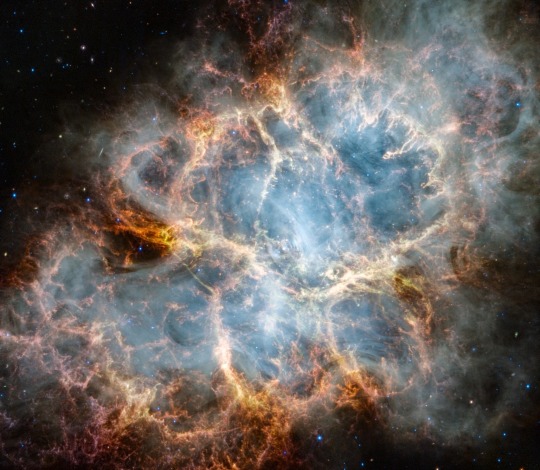
Crab Nebula, taken by the James Webb Space Telescope’s NIRCam (Near-Infrared Camera) & MIRI (Mid-Infrared Instrument)
Published by NASA 10/30/23
#photography#space#telescope#james webb space telescope#nebula#crab nebula#universe#stars#infrared#astronomy#galaxies#discovery#science#nasa
101 notes
·
View notes
Text
2024 April 3
A nebula is shown that appears like a firework. Radial filaments connect a glowing halo to a star in the center that appears as a blue dot.

Unusual Nebula Pa 30
Image Credit: NASA, ESA, USAF, NSF;
Processing: G. Ferrand (U. Manitoba), J. English (U. Manitoba), R. A. Fesen (Dartmouth), C. Treyturik (U. Manitoba);
Text: G. Ferrand & J. English
Explanation: What created this unusual celestial firework? The nebula, dubbed Pa 30, appears in the same sky direction now as a bright "guest star" did in the year 1181. Although Pa 30's filaments look similar to that created by a nova (for example GK Per), and a planetary nebula (for example NGC 6751), some astronomers now propose that it was created by a rare type of supernova: a thermonuclear Type Iax, and so is (also) named SN 1181. In this model, the supernova was not the result of the detonation of a single star, but rather a blast that occurred when two white dwarf stars spiraled together and merged. The blue dot in the center is hypothesized to be a zombie star, the remnant white dwarf that somehow survived this supernova-level explosion. The featured image combines images and data obtained with infrared (WISE), visible (MDM, Pan-STARRS), and X-ray (Chandra, XMM) telescopes. Future observations and analyses may tell us more.
#astronaut#astronomers#not astrology#star#stars#art#astronomy#outer space#space#artist#nebula#celestial#firework#Pa 30#1181#supernova#SN 1181#dwarf star#zombie star#telescopes#telescope#X ray#infrared#nebulas
43 notes
·
View notes
Text


These two stunning images show the same cosmic object, located 160,000 light-years away, captured by the Hubble Space Telescope.
The blue image highlights near-infrared and visible light, while the red image covers near-ultraviolet to infrared light.
Astrophysicists believe the first generation of stars ejected matter, which, due to the cluster's high density, couldn't escape its gravity.
Credit: NASA
#art#cosmos#cosmic#universe#blast#space#photography#stars#light#cosmic object#hubble space telescope#nasa#infrared light#milky way#galaxy
19 notes
·
View notes
Text

NGC7293 Helix Nebula in Acuarius In Infrared. Spitzer Telescope/ NASA. Procesed: Judy Schmidt.
#ngc7293#helix nebula#acuarius#constellation#infrared#spitzer space telescope#nasa#judy schmidt#space#universe#cosmos#galaxy#nebula
324 notes
·
View notes
Video
NASA's Chandra, Webb Combine for Arresting Views (Pillars of Creation) von NASA's James Webb Space Telescope
#chandra#jwst#multiwavelength astronomy#webb#james webb space telescope#infrared#x-ray#Hubble#flickr
17 notes
·
View notes
Text
rip Duke Thomas you would have loved the Spaceship Spitzer podcast
#duke thomas#batfam#this is an Extremely Niche thing for just me#for those of you whos parent was Not a space autistic spaceship spitzer was an early podcast in the style of a radioplay#where the infrared telescope Spitzer was actually a spaceship#and like Hyjinks insue its been like literally 15 years#my dad was really into it and we listened to it with him XD#anyway this is for the duke is an astronomy nerd girlies#bread talk
16 notes
·
View notes
Text
Comet NEOWISE rising over the Earth just before dawn as seen from the International Space Station. ☄️
—
C/2020 F3 (NEOWISE) or Comet NEOWISE is a long period comet with a near-parabolic orbit discovered on 27 March 2020 by astronomers during the NEOWISE mission of the Wide-field Infrared Survey Explorer (WISE) space telescope.
#Comet NEOWISE#C/2020 F3 (NEOWISE)#NEOWISE#Wide-field Infrared Survey Explorer (WISE)#space telescope#comet#International Space Station#Earth#space#astronomy#astronomers
69 notes
·
View notes
Text
Striking new Webb image showing alignment of bipolar jets confirms star formation theories
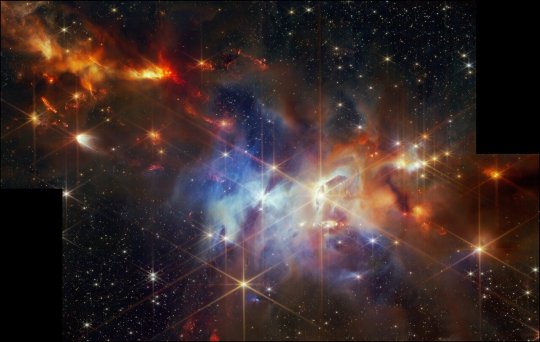
(Credit: NASA, ESA, CSA, STScI, K. Pontoppidan (NASA's Jet Propulsion Laboratory), J. Green (Space Telescope Science Institute))
"For the first time, a phenomenon astronomers have long hoped to image directly has been captured by the NASA/ESA/CSA James Webb Space Telescope's Near-InfraRed Camera (NIRCam). In this stunning image of the Serpens Nebula, the discovery lies in the northern area of this young, nearby star-forming region.
The astronomers found an intriguing group of protostellar outflows, formed when jets of gas spewing from newborn stars collide with nearby gas and dust at high speeds. Typically, these objects have a variety of orientations within one region. Here, however, they are all slanted in the same direction, to the same degree, like sleet pouring down during a storm."
"So, just how does the alignment of the stellar jets relate to the rotation of the star? As an interstellar gas cloud collapses in on itself to form a star, it spins more rapidly. The only way for the gas to continue moving inward is for some of the spin (known as angular momentum) to be removed.
A disk of material forms around the young star to transport material down, like a whirlpool around a drain. The swirling magnetic fields in the inner disk launch some of the material into twin jets that shoot outward in opposite directions, perpendicular to the disk of material."
continue reading
#astronomy#universe#space#james webb space telescope#jwst#wavelengths#infrared#bipolar#stars#planets#visible spectrum#invisible spectrum#light#color#rotation#spinning#magnetic field#magnetism#plasma physics
25 notes
·
View notes
Text
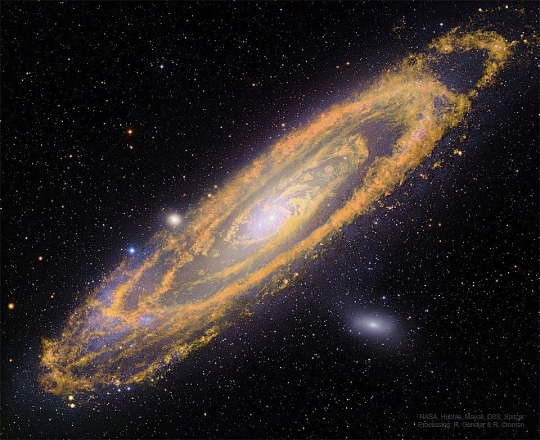
SPACEMAS DAY 7 ✨🪐🌎☄️☀️🌕
The big, beautiful Andromeda Galaxy, M31, is a spiral galaxy a mere 2.5 million light-years away. Image data from space-based and ground-based observatories have been combined here to produce this intriguing composite view of Andromeda at wavelengths both inside and outside normally visible light. The visible light shows where M31's stars are now, highlighted in white and blue hues and imaged by the Hubble, Subaru, and Mayall telescopes. The infrared light shows where M31's future stars will soon form, highlighted in orange hues and imaged by NASA's Spitzer Space Telescope. The infrared light tracks enormous lanes of dust, warmed by stars, sweeping along Andromeda's spiral arms. This dust is a tracer of the galaxy's vast interstellar gas, raw material for future star formation. Of course, the new stars will likely form over the next hundred million years or so. That's well before Andromeda merges with our Milky Way Galaxy in about 5 billion years.
Image Credit: NASA/Hubble
#astronomy#space#science#universe#spacemas#day 7#andromeda#andromeda galaxy#galaxy#new stars#visible light#infrared light#Hubble#spitzer telescope#future stars#galaxy collision#follow#like#reblog#the first star#the first starr#thefirststar#thefirststarr#nasa#apod#tumblr#blog#space blog#spiral galaxy#spiral
66 notes
·
View notes
